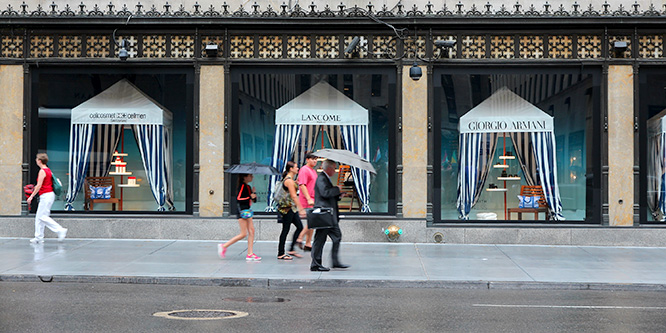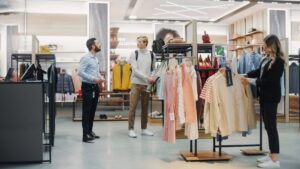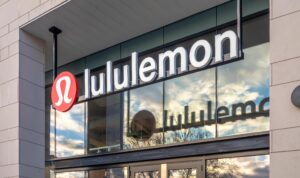
Photo: Getty Images/tupungato
July 19, 2022
Is luxury retail’s sweet spot?
The latest “Saks Luxury Pulse” survey finds higher-income consumers continuing to spend on luxury despite record inflation and a plunging stock market.
According to the survey of over 2,100 U.S. consumers fielded between May 24 to 27:
- Seventy-six percent with an income of $200,000 or more plan to purchase the same or even more luxury items in the next three months than they did in the past three months.
- When asked where they would spend an extra $500, respondents with an income of $200,000 or more would spend first on vacation and leisure travel (38 percent), followed by shoes, accessories and handbags (29 percent).
Marc Metrick, Saks’ CEO, said in a statement, “The luxury customer remains highly engaged with fashion.”
The ongoing momentum in luxury spending this year was also called out by recent reports from Bain and Bank of America (BOA).
In 2021, U.S. luxury spending surged 47 percent higher than pre-COVID 2019 levels, according to BOA. Luxury’s gains have been attributed to “revenge spending” or pent-up demand following lockdowns. Luxury was also a key category for splurging while eating out, entertainment and travel faced restrictions. Wealthier Americans also enjoyed soaring stock and home prices.
For 2022, luxury spending is up 14 percent through May, with growth accelerating to 26 percent for higher-income spenders and slowing to five percent for lower-income earners, according to BOA.
BOA attributed the strong higher-income consumer demand “to reopening and more purchase occasions (return of weddings, galas, holidays, etc.).”
Bain in June raised its 2022 global outlook for luxury due to healthy double-digit growth in the first quarter, despite weakness in China tied to lockdowns.
Bain said Europe’s luxury sales are recovering faster than expected due to a “fierce ‘back to normal’ attitude and a rebound in intraregional tourism,” while U.S. luxury is “experiencing unprecedented growth as luxury brands are unleashing the real power of diversity and inclusion, discovering the true potential of the entire American customer base.”
However, Bain found the overall “resiliency” of luxury spending in the face of macro-economic challenges, including hyperinflation, slowing GDP growth and the Russia-Ukraine conflict, far stronger than expected. Bain partner Claudia D’Arpizio told Reuters, “We were for sure astonished.”
- Saks Luxury Pulse Finds Consumers are Spending on a Luxury Lifestyle – Saks/Business Wire
- Why Luxury Goods Sales Are Surging In The Pandemic – Northeastern University
- How Luxury Survived the Pandemic – The Washington Post
- Luxury spending is soaring despite economic headwinds, Bank of America reports – CNN Business/WRAL TechWire
- Global personal luxury goods market reaches €288 billion in value in 2021 and experienced a remarkable performance in the first quarter 2022 – Bain & Co.
- Luxury sales to grow at least 5 percent this year – Reuters
- What Will a Recession Mean for the Luxury Market? – Business Of Fashion
- Luxury Brands Are Counting on Americans to Keep Spending – The Wall Street Journal
Discussion Questions
DISCUSSION QUESTIONS: What do you think is driving the apparent strength in the luxury market and do you expect it to continue? Does the luxury market appear better positioned for growth post-pandemic versus pre-pandemic?
Poll
BrainTrust
Paula Rosenblum
Co-founder, RSR Research
Recent Discussions







There are many drivers. In emerging markets, the continued rise in wealth and income is fueling growth. Luxury brands have also been good at digital and social promotion, which has increased interest from all consumer groups. Rental options have also encouraged more people to try luxury, resale has done the same – and has given consumers the opportunity to monetize luxury products they no longer want. Inflation and more constrained incomes will take something of a toll, but these things do not have a dramatic on luxury’s affluent consumers. And for consumers on more modest incomes, luxury is often a priority area of spending because brands understand how to add value and create compelling products.
Right on the mark — and the money. Luxury will continue to thrive as aspirational consumers and the wealthy buy into products that have a longer life.
Liquidity in a very small group of people is driving this. Great for the retailers and manufacturers involved in the luxury markets. Doesn’t do much for those retailers in lower-price markets.
Retail therapy is alive and well! While consumers cannot control outside forces, they can control their spending and surround themselves with luxury items, since a cashmere sweater feels better than a wet blanket of inflation.
Saks’ core customer doesn’t care that gasoline is pricey or the stock market took a quick dip. Saks’ leaders have served these customers well. The real challenge is the one facing retailers addressing the 99 percent.
…and the gap between the 1 percent and the 99 percent has only gotten bigger during the pandemic.
There is a pent up demand from the COVID-19 period of not being able to travel, eat out and socialize. Add this to the fact that higher income consumers are less impacted by inflation and price increases and you have a strong demand for luxury items. Most people cannot take more holidays, particularly if they are still working so that wealth that has not been spent in the last couple of years is available for consumption of luxury items. While lower earners are struggling more they will want a treat to escape the current situation, this may not be high volume but adds to the rest. In essentials like food people will trade down, in other goods they tend to trade up as a treat.
Pent-up demand, loosened global travel restrictions, and the limited but consequential rise in wealth have all contributed. Luxury brands have also become much more comfortable and adept at navigating the digital realm and direct-to-consumer outreach. The post-pandemic picture for luxury brands looks bright, even if the luxury retailers of the past aren’t driving it.
One tier of customers has plenty of free cash flow while a whole bunch of lower tier customers are pinching pennies at the grocery store so they can fill their gas tank. Turn on the air conditioner? Not so fast. Luxury spending is the norm for the few, and it’s aspirational for the many. Let’s hope this bifurcating economy doesn’t squeeze the many for too much longer.
I think it’s a rebound effect and if the economy and stock market don’t stabilize soon, luxury will face serious headwinds.
Even soaring inflation can’t dampen enthusiasm for luxury goods.
Leisure funds went untouched during the pandemic. Now more shoppers invest in indulgence as life opens up again. Omnichannel access fuels online product discovery and research while stores seal the deal.
The post-pandemic market will be bigger than ever as luxury brands target younger and more diverse consumers. Luxury brands prioritize the store experience, anti-counterfeit measures, TikTok and metaverse marketing to drive sales. Also, brands like Chanel have hiked prices to command a more exclusive positioning.
Luxury’s affluent consumers are the last to feel the effect of negative macroeconomics. As the stock market continues to slide, high-end purchases will decline, and the final retail domino will fall in the current business cycle.
Consumers with considerable disposable income rarely feel the pinch of inflationary effects, but if inflation gets to double digits (which it likely will), then the lower end of the luxury market will cool quickly. And as the Fed continues to raise rates, the post-pandemic market for luxury goods will become more problematic than before COVID-19 hit us.
Hedonism, as I predicted, is the reaction to the end of the pandemic. I still believe it is working through the economy. I don’t see people picking up luxury items wondering if/when they go on sale. Whatever the cost, we want to escape our Kryptonite lives. We want to be heroes. Retailers that understand that will need to up their game with employees because we don’t want the products, we want the feeling they give us.
The polarization of the economy continues. The rich get richer and everyone else moves to off-price or nothing. Luxury return rates for online fashion sales hover at over 60 percent in many of these brands, yet they still make money. There will always be a strong luxury market that is immune to the volatility of the market. Maybe it’s time for a separate Consumer Price Index for the wealthy.
Still, while the luxury retail market is positioned to do better, resale luxury will experience a reality check. Resellable assets, such as designer handbags, luxury watches, or cars, are already experiencing a 10 percent+ decrease since the beginning of the latest interest rate increase. Discretionary spending will decrease eventually, but it will still be higher than pre-pandemic levels.
The luxury and aspirational markets will continue to thrive despite the economic headwinds, rising inflation rates, and rising living costs. Luxury is on the upper spectrum of the retail market, and its core customers aren’t as susceptible to the shifting macro-economic situation. While the luxury segment isn’t entirely recession-proof, the iconic brands’ collective equity and authentic storytelling across digital and physical channels continue to power a retail segment showing no signs of slowing down.
As conscious consumerism kicks in, customers are rationalizing their discretionary purchase decisions. Attainable or aspirational luxury items are within reach, considering the brand equity and the move to buying more quality items over quantity will undoubtedly keep the industry going. It’s also fascinating to see the resale luxury market and circular fashion, led by RealReal, thriving, as customers want to experience luxury products while shopping responsibly and at a lower price tag.
Luxury/ultra-luxury goods tend to be recession-proof. The wealthy individuals (celebrities, top 1%) who purchase these products are rarely impacted by macro-economic events too much to alter their behavior. Consumers who see luxury as aspirational are the ones to postpone or decline making luxury purchases during uncertain times.
In area of inflation, luxury goods that hold their value and sometimes appreciate is better than cash. Given the travel meltdown happening right now, luxury travel is being replaced by luxury purchases which help to drive short term growth.
U.S. luxury spending surged 47 percent higher…. Inflation: meet your sponsor.
People aren’t hibernating any more and the more people with money go out and spend money, the more the luxury market will continue to show strength, even with the economic headwinds. Luxury brands actually offer stoppable stores, higher merchandising standards and better goods, with the pricing discipline to match.
Luxury brands are enjoying growth and get the added bump with the increase in travel (which goes hand-in-hand with duty-free designer brand purchases). Just yesterday I saw a substantial line outside Chicago’s Gucci store, where they limit the number of clients. Some may be wealthy while others covet rare accessories that telegraph status.
When you peel the layers of the onion a bit, you’ll find that their limited edition collections and collaborations with artists have energized older luxury brands and opened access to younger markets. Louis Vuitton x Supreme was one of the earlier examples that appealed to both high fashion and streetwear enthusiasts back in 2017. Leveraging social media and the hype surrounding exclusive drops, the company saw 20 percent annual growth.
Fast forward to June 2022 when Gucci announced their HA HA HA collection with performing artist Harry Styles.
These partnerships allow luxury houses more “brand width” as they are positioned alongside the partner’s social purpose and sustainability commitments. They also freshen the fashion house’s iconic designs to appeal to Millennials.
If retail brands pitched to middle-income shoppers were to take a page from these marketing strategies, then indeed luxury could be retail’s “sweet-spot.”
People have developed an increased interest in polishing their quality of life. Not only the consumers with high disposable income but also those with moderate earnings are sliding into the world of luxury. The foremost reason is the pandemic. People have learned life lessons the hard way, embracing uncertainty has become the new normal. Amid so many crises, from lockdowns to skyrocketing inflation to the Russia-Ukraine war, people have reconciled their contemplations. With the expanded horizons, they are now consciously thinking over their desires. Post-pandemic, with new priorities, consumers now want to explore more, travel, and spend on products and experiences that make them happy. Additionally, tremendous advancements in tech have also contributed to fueling demand in the luxury market. With new trends and technological innovations, the upper-middle class consumers are also seeking to upscale their earnings. So as a consequence, the dominance of the luxury market will continue to prevail.
The past few years have thrown any sense of austerity out of the window, everyone wants some sort of escape and the luxury industry provides the path. When this sentiment is coupled with brands that really understand the pulse of their client’s desires the market will continue to find success.
Kering in particular represents luxury with the most loved designers, Gucci itself is driving 32% of revenue growth. All of these stars aligning mean there will be continued success for the luxury market, a bigger question is now each house will differentiate themselves to be more competitive.